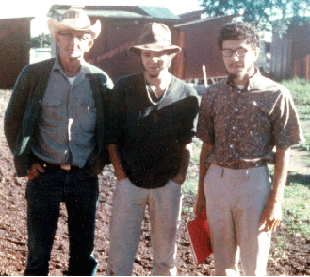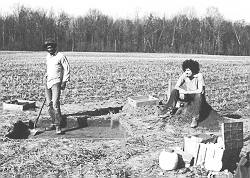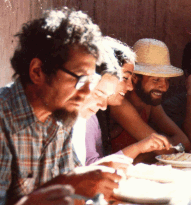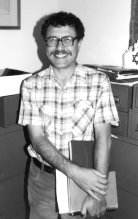
|
For a much more detailed biography, which focuses on
professional matters but goes only up to 1987, see Chapter 1 of
Behavioral Archaeology: First Principles (complete reference
under,
My
Books).
I was born on October 4, 1947, in Winnipeg, Manitoba, Canada. My father, Louie Schiffer (1918-2007), raised chickens on a small farm with his parents and numerous siblings. Also a Canadian, my mother, Frances-Fera Schiffer (1925-2008), was born in Toronto, Ontario. Following other members of the large Schiffer clan, the Louie Schiffer family immigrated to Los Angeles, California, in 1953, seeking warm weather and fortunes to be made in the land of sun, surf, and orange groves. Regrettably, no fortune was made, but I did have a happy--almost idyllic--childhood. My parents provided a loving and supportive home in which I was encouraged to be creative and pursue my interests.
|

|
I attended Audubon Junior High School and Dorsey High School, both in
the Crenshaw area of what is now called "south-central" Los Angeles. It
was a marvelous place for a teenager to mature, a lower middle-class
neighborhood that had considerable ethnic diversity long before forced
busing. At Dorsey High School, I took lots of math and science classes,
intent on becoming an electrical engineer or chemist.
Schiffer (far right) at Vernon, Arizona 1968.
|
|
After graduation from Dorsey in June, 1965, I matriculated at the
University of California at Los Angeles, following in the footsteps of
my cousin, Dr. Lawrence H. Lazarus, where I majored in chemistry. As a
sophomore, seeking wider horizons, I changed majors to anthropology, and
eventually took courses in archaeology from James N. Hill, Sally R.
Binford, James Sackett, and Lewis R. Binford. In my junior year I
decided on a career in archaeology.
In the summer of 1968, I participated in the Field Museum of Natural History's Southwest Expedition, based in the hamlet of Vernon, Arizona. There I came to know the Expedition's Director, Paul Sydney Martin, and its senior staff, Fred Plog, Mark Leone, and Ezra Zubrow. It was an interesting mix of personalities. Although receiving generous fellowship offers from UCLA, Michigan, and Arizona, I decided to attend the latter for graduate school. During the summers of 1969-71, I returned to Vernon, eventually gathering dissertation data from the Joint Site, a 36-room pueblo, excavated jointly with John Hanson, David Gregory, and Fred Gorman. Many rumors abound about how this site was named; some are true. |
|
In graduate school I took archaeology courses from William A. Longacre,
T. Patrick Culbert, and Emil Haury, but Raymond H. Thompson chaired my
dissertation committee. I interacted most with fellow graduate students J. Jefferson Reid, James T. Rock, Mark Harlan, David R. Wilcox, Michael
Collins, and Henri Luebbermann II, as well as with new faculty member
William L. Rathje. It was out of this group that the rudiments of
behavioral archaeology emerged.
Excavating in the Cache River Basin, Arkansas, 1974. |

|
|
"Behavioral archaeology" meant many things to many people then, just as
it does now. It was a perspective intended to reintegrate a discipline
seemingly going off in all directions (just look at the papers in
American Antiquity during the early 1970s). As a theoretical
program,
it privileges behavior--what people actually do, recognizing that all
behavior (defined as activities) consists of people-artifact
interactions. Also implied is an interest in the life histories of
artifacts, whether one represents these as flow models or activities in
behavioral chains. Behavioral archaeology also strives to
understand and take into account, in archaeological inference, all
relevant cultural and noncultural formation processes of the
archaeological record.
My doctoral dissertation, a hasty effort cobbled together--a bricoleur's work, some might say--in less than a year, was defended on August 14, 1973. The next day Annette and I moved to Fayetteville, Arkansas, where I took up a position doing contract projects with the Arkansas Archeological Survey. It took me several months to understand that "soft money" meant I would be on the job market again soon. Working with Hester Davis, Charles R. McGimsey, and others, I came to appreciate the complexities of trying to build into all contract projects considerations of modern method and theory. The Cache River Archeological Project (CRAP) consumed my first year at Arkansas; much smaller projects, revising my dissertation, and job hunting the second. I was fortunate to receive an offer from the University of Arizona, where I had always longed to return. I took up the position of Assistant Professor in August, 1975. Immensely pleased with this turn of events, I did not even negotiate my salary--a mistake for which I am still paying. |

In the field, Northern Chile, 1985 |
The Reuse Project, an ethnoarchaeological study of reuse processes in Tucson, was my first major undertaking at Arizona. In 1979 I was promoted to Associate Professor with tenure. Also in 1979 I began preparing, with Randall H. McGuire, an archaeological overview of southwestern Arizona for the Bureau of Land Management. William L. Rathje and I started work in that same year on our introduction to archaeology, which was called, not surprisingly, Archaeology. Archaeology was a thinly disguised synthesis of our version of behavioral archaeology. In 1982, with the imminent appearance of several major publications, I was promoted to Professor. Shortly thereafter, I began to grey around the temples. |
|
Concerned that archaeology students lacked facilities for carrying out
experiments and analyzing materials, I began in 1983 to collect
equipment and write grant proposals for what would become, in 1984, the
Laboratory of Traditional Technology. (My success rate on N.S.F.
proposals was 25%--hope springs eternal.) Collaboration with James M.
Skibo, an advanced graduate student and the Laboratory's Assistant
Director
until 1991, resulted in many jointly-authored publications in ceramic technology and
archaeological theory and method.
Although I continued research on formation processes throughout the early 1980s, which led to the book Formation Processes of the Archaeological Record, my interests had shifted decisively toward technological change. These interests expanded in the late 1980s to include historic electric and electronic technologies. Under the prodding and intellectual stimulation of W. David Kingery, who had joined our faculty in 1988, I turned a hobby--collecting portable radios--into a serious study of technological change. Next I investigated the early history of the electric automobile (but I do not collect them). These two unusual projects would have diverse spin-offs for archaeological theory and method. My trademark goatee, a transparent knock-off of Binford's, began to whiten, so I shaved it off and haven't missed it. My white mustache would soon suffer the same fate but Annette is fond of it. From 1992 to 1995, Patrice Teltser, an evolutionary archaeologist, was a Visiting Scholar in the Laboratory of Traditional Technology. Countless discussions with her convinced me that there was some common ground between evolutionary and behavioral archaeologies. In seeking the shared tenets, I read in evolutionary theory and animal behavior. Rapidly I became convinced that a much more pressing project was to construct a general theory of human communication informed by an archaeological perspective. From 1994 to 1998 I built just such a theory with the help of Andrea R. Miller. |

Main office of the Anthropology Department at the University of Arizona circa 1996. |
After completing The Material Life of Human Beings: Artifacts,
Behavior, and Communication in 1998, I turned my attention to the
study
of the earliest electrical technologies--from the 18th century. A
book on this subject was published in 2003 (see
My Books). My next project was a book on the history of electrical science and technology, ca. 1800 to 1880. During this period, the foundations were laid for Edison's commercial and technological successes. Currently I am working with Kacy L. Hollenback on a synthesis of behavioral archaeology. Another ongoing project is a book on the study of technological change.
Fresh generations of graduate students--some even interested in behavioral archaeology--have kept me on my toes, forcing me to rethink basic issues and churn out new ideas and papers. I am also returning to an old love, making pottery; I hope someday to achieve excellence in this craft. Annette and I spent our summers from 1994 to 2002 in Pinetop, Arizona. Our 25th anniversary present to each other was a small cabin there. During those years, my most productive writing and thinking time was in Pinetop, away from committees, memos, and an intrusive and malevolent university bureaucracy. We now spend part of the year in Alexandria, Virginia, where we own a tiny condo. Upon Professor William A. Longacre's retirement in 2004, the Department of Anthropology elected me the Fred A. Riecker Distinguished Professor. |
